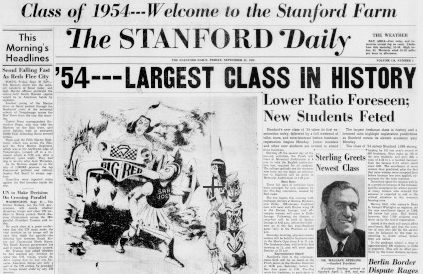The feature “On this day in Stanford history” details unusual or humorous events that occurred on the same date or week in past years from The Daily archives.
According to The Stanford Daily archives, on Sept. 22 in …
1897: University President David Starr Jordan and his secretary George A. Clark prepared to leave for the conference of the International Seal Fishery Commission in Washington, D.C. The U.S., Japan and Russia were all part of the commission and anticipated the signing of a treaty protecting the seal herds. Jordan expressed that “rather than see the seal herds exterminated, he prefers to see them pass into the possession of England.” He also requested the sessions of the commission kept secret and without record to “avoid further diplomatic complications.”
1899: During a meeting of the senior class, it was reported that the committee on class hats had decided upon the sombrero. On behalf of the girls of the class, a student identified only as Miss Fraser decried the decision, stating that they would adopt the traditional cap and gown and “would begin to wear the mortar-board on the same day that the men of the class put on the sombrero.”
1902: Looks like the petition led by Miss Fraser was overpowered, as on this day the senior class accepted a report by F. F. Gundrum, chairman of the committee on sombreros. The class planned to purchase the hats from a local shop called The Haberdasher.
1916: In this Daily issue’s “Special Notices” section (a precursor to the modern-day “Free and For Sale”), one student posted, “If the party that lost the bicycle, Saturday night, September 9th, at The Wonder Saloon, will call at this office and pay for this ad, they will be told where the wheel is.” Potential open-faced savagery? Or good samaritan trying to help out a poor bicycle-less foot-traipser?
1933: University President Ray Lyman Wilbur gave a friendly welcome to the new freshman class, saying, “We want Stanford to mean something so tangible and so fine to you that it will become a permanent part of your lives. Thousands of Stanford men and women look back upon their days in the University with deep satisfactions and the real appreciation of the associations and opportunities offered them.” (Welcome, class of 2021!)
1945: Soon after Japan’s attack on Pearl Harbor, Stanford opened Sequoia Hall up to the War Department for the purpose of housing soldier trainees in the Civilian Defense Training School. After being used as a barracks and training center for soldiers during World War II, Sequoia Hall was finally closed for being in desperate need of repair.
1950: Stanford’s class of ’54 was noted to be the tallest in its history after University officials examined the height records of the 500 freshmen enrolled. After realizing that nearly half of the class was over six feet tall, the University issued an emergency order for more seven-foot beds. According to a Daily article, the “only man at the University who was completely delighted with the situation was Everett Dean — the University’s basketball coach.”
1967: Little-known fact: The freshman “lookbook” that is distributed as part of orientation materials during New Student Orientation was originally intended as a dating guide for incoming frosh. In this issue, it was announced that “Stanford’s Froshbook, the traditional dating guide containing pictures of the entire freshman class, will not appear until early November. The Froshbook is usually distributed during Pre-Registration.”
1995: Following a May 1994 hunger strike on campus that petitioned for a University-wide ban on grapes, Stanford instituted a new policy that called for Resident Assistant (RA)-led “educational sessions on the treatment of workers harvesting California table grapes.” This decision created dissatisfaction among some RAs, who voiced concerns about the divisiveness of the issue in residence communities.
Contact Claire Wang at clwang32 ‘at’ stanford.edu.
